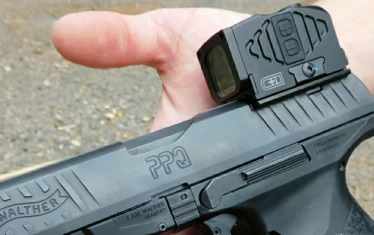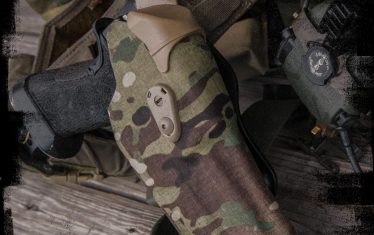Owning and handling a firearm requires a steadfast dedication to safety. It’s a full-time job and not one that should be taken lightly.
Whether you live alone in an apartment or with a brood of kids in a split-level home, it’s important to remember that gun safety applies to you, and everyone and everything around you.
It doesn’t matter if you’re a seasoned shooter or a first-time gun owner; mastering and practicing the 10 commandments and fundamentals of basic handgun safety is an absolute must.
Without further ado, let’s dive in.
The 10 commandments of gun safety
These 10 Commandments of Gun Safety apply to all guns, not just handguns. Memorize and internalize them; make them a part of your daily regimen. No exceptions.
Commandment 1: Treat Every Gun As if it is loaded
This is the cardinal rule; the most important rule. Even if you know a gun is clear and unloaded, don’t take any chances.
Keep your finger away from the trigger with the gun pointed down range or in a safe direction.
Never point it at someone or something you don’t intend to shoot.
We’ve all heard the horror stories and read the statistics. Please don’t become one of them.

Commandment 2: Always keep the muzzle pointed in a safe direction
Keeping the muzzle pointed in a safe direction drastically reduces the risk of an accidental injury to you, your loved ones, and innocent bystanders as well.
If you live in multi-family housing (apartments and duplexes), be especially mindful and practice extreme muzzle discipline. What seems like a safe direction may actually be placing an innocent neighbor directly in line with the muzzle. In fact, it’s ill-advised to handle any firearms in multi-family housing.
Commandment 3: Keep your finger off the trigger until you’re ready to shoot
Good trigger discipline is just as important as muzzle discipline.
Keeping your finger off the trigger until you’re truly ready to fire and prepared to shoot prevents accidental discharges. Accidental discharges account for hundreds of gun-related deaths and thousands of injuries per year.
Protect yourself, your friends, and your neighbors; keep your finger off that trigger.
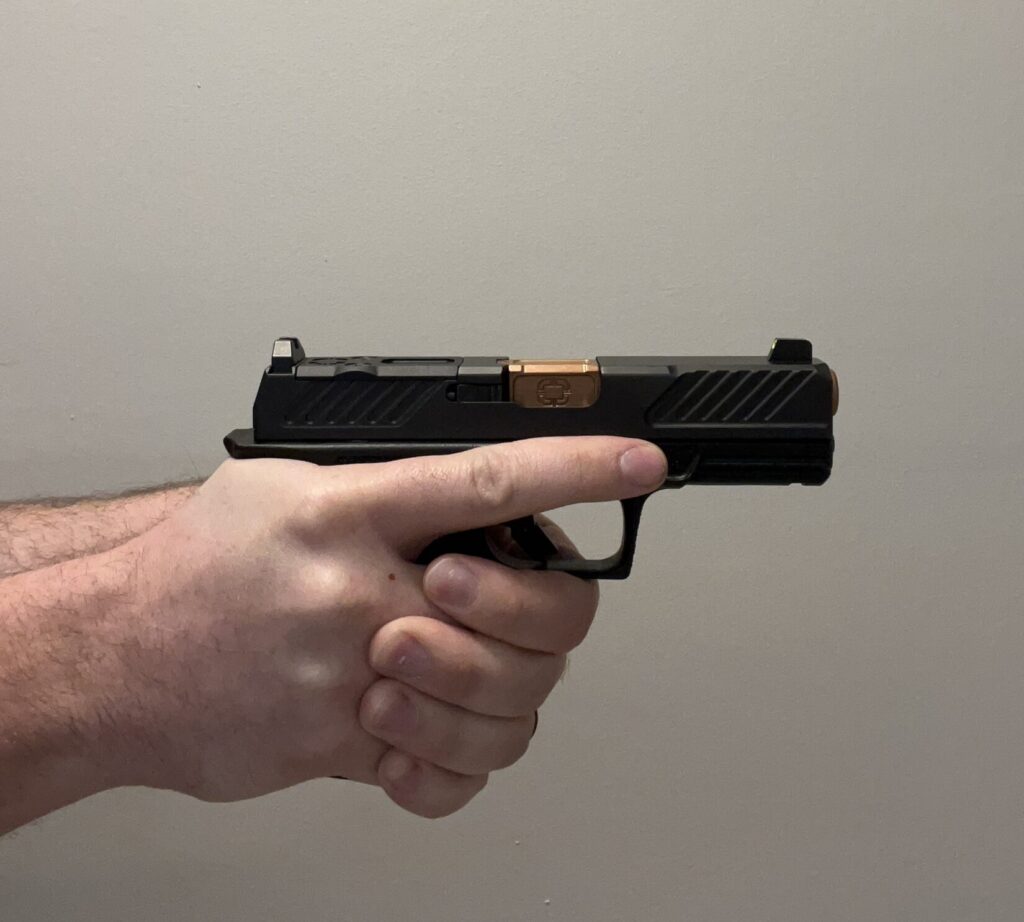
Commandment 4: Know your target and What’s beyond it
Be aware of what you plan to shoot at, and what’s behind it, beside it, above it, and below it.
Are you shooting at a paper target stapled to an empty box, laid on a flat surface with nothing but houses around you?
Is there a safe backstop behind your target, or a rock bluff that might cause a ricochet?
Knowing what you’re shooting at is one thing, but you must be sure that the bullet will be stopped and contained safely.
Before engaging (shooting at) a target, be certain that you’ve correctly identified your target to avoid shooting at anything or anyone you didn’t intend to. If you’re not sure, it’s never safe to assume.
Commandment 5: Always wear Ear and Eye Protection
Don’t rely on generic sunglasses or your everyday eyeglasses. Invest in some quality shooting glasses or OSHA-approved safety glasses. These will have a “Z-code” stamped on the frame, which indicates that the glasses are impact-tested to withstand impacts from sharp, fast-moving objects.
In the event of a catastrophic failure, everyday eyewear would fail to protect your eyes from flying debris, and instead, may pose a larger risk of injury should they break or shatter.
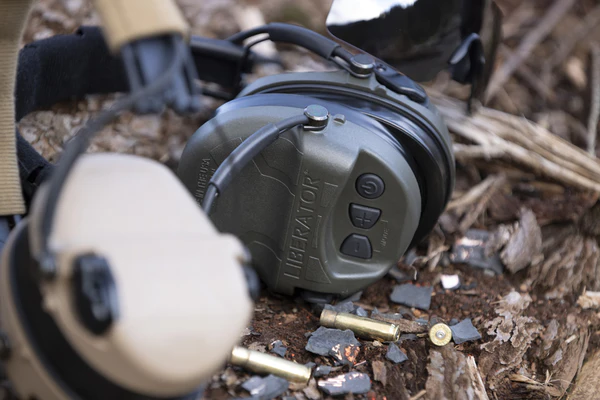
Likewise, it’s highly advised that you invest in quality over-the-ear ear protection, like Safariland Liberator HP 2.0 earmuffs.
Quality over-the-ear ear protection will protect your eardrums from harmful concussions, which often result in inner ear pain and permanent hearing loss.
Commandment 6: Know your gun and how to safely handle it
Familiarity with your firearm is essential. Take the time to read the owner’s manual and become familiar with features, mechanics and operation, safety mechanisms, chamberings, and so on.
Never assume you know how to operate safeties, charge the weapon, or fire the weapon. Even if you’re an experienced shooter, don’t make the mistake of assuming.
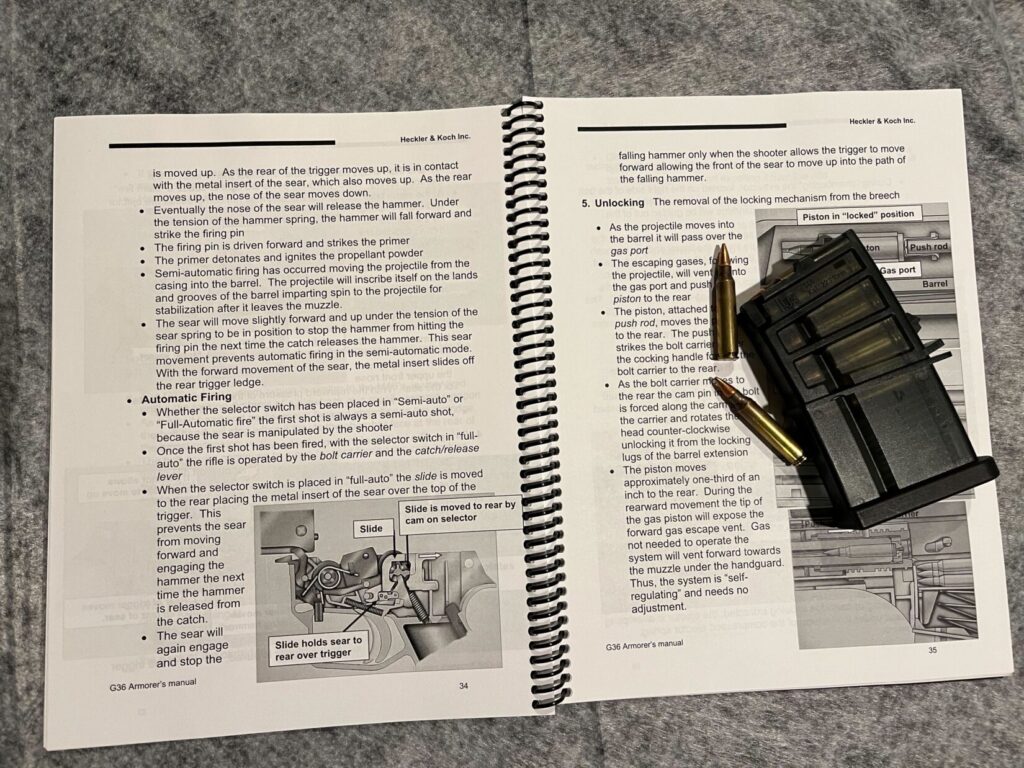
Commandment 7: Use the correct ammunition
Every gun should have markings on the action or barrel that indicate what ammunition to use. Likewise, the owner’s manual will provide insight into what ammunition to use, and what to steer clear of. Be sure to check the manual and the barrel or action of the firearm to ensure you’re using the correct ammunition.
Always use the correct caliber and ammo type specified by the manufacturer. For example, don’t try to fire a .380 ACP cartridge through a handgun chambered in 9mm or vice versa.
Likewise, don’t attempt to fire +P (high-pressure) ammunition through a firearm not rated for +P ammunition. This will ensure safe and reliable operation and avoid the risk of catastrophic failures, injury, or death.
Commandment 8: Store your guns in a safe, secure location
Store your firearms in a safe and secure location where kids and other unauthorized users cannot gain access.
Invest in a gun safe, vault, lockable gun case, or a lockbox. Not only will this reduce the risk of theft, but it will also protect curious kiddos and uneducated users from accidents, injuries, and death.
At home, keep guns locked away when not in use. If you’re transporting your guns, make sure they’re in your trunk, out of sight, and stored in lockable cases or theft-resistant gun vaults.
Never leave guns unattended, especially in a vehicle.

Commandment 9: Avoid Drugs and alcohol when handling guns
Guns don’t mix well with drugs and alcohol.
Nothing ever good comes from an inebriated fool wielding a gun at a party. Even if you’ve only had a half of beer, you’re no longer in a safe condition to handle firearms. In fact, in many states, it’s a felony to possess a firearm while under the influence of drugs or alcohol.
Just don’t do it.
Commandment 10: Clean and Service your firearms regularly
Ensuring that your gun is clean, clear of obstructions, and mechanically sound is a must to reduce the risk of failures, injury, and death.
Before taking your guns to the range, take a moment to double-check that the bore is free of any dirt, debris, or foreign objects.
Clean your guns often, take them to a qualified gunsmith for service regularly, and ensure that the firearm functions as it should.
If in doubt, do NOT take your gun to the range and have a gunsmith take a look at it instead.
Other considerations
Now that we’ve gone through the 10 Commandments of Gun Safety, there are a few handgun-specific safety tips you need to know, including obtaining the proper grip and shooting stance.
The Proper shooting grip
Obtaining the correct shooting grip on a handgun takes time and practice, but it’s fundamental to safely handling and controlling a handgun. Further, without the proper shooting grip, delivering accurate hits on target is nearly impossible.
Let’s discuss how to obtain a comfortable shooting grip on your handgun.
Place your dominant hand high on the backstrap of the pistol, ensuring a firm connection between the web of your hand and the tang of the grip.
Wrap your fingers around the grip, maintaining a natural, relaxed position. Avoid excessive tension that may hinder your ability to control the firearm or maintain a steady sight picture.
If your hands are shaking or your arms are overly stiff with your muscles flexed, ease off a bit.
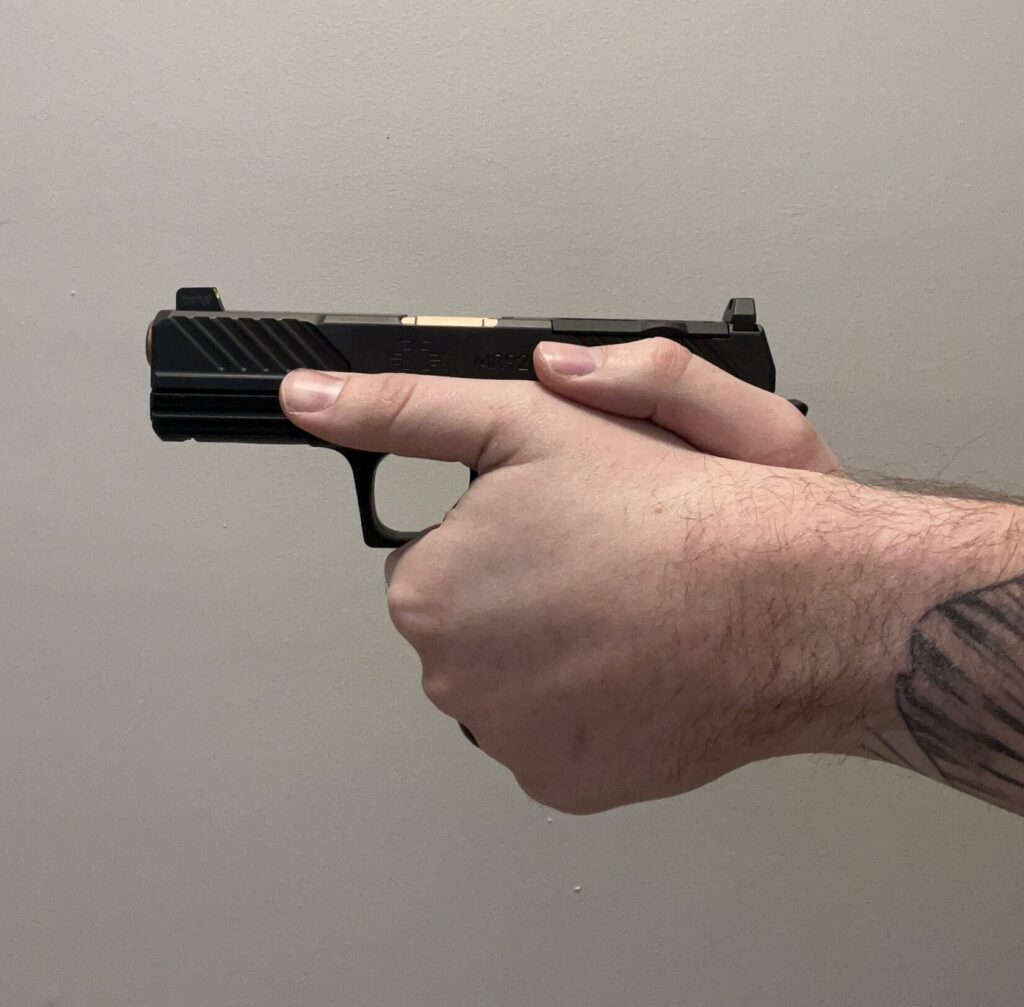
Position your trigger finger along the frame of the pistol, indexed, and ready to engage the trigger, but ensure your finger remains outside the trigger guard until you’re ready to fire.
Bring your non-dominant hand up to meet the dominant hand, forming a solid two-handed grip.
Further, point your thumbs forward along the frame of the handgun, parallel to the barrel. This helps mitigate the effects of recoil by providing better control.
Squeeze the handgun firmly, but avoid excessive tension.
The Proper shooting Stance
With your arms fully extended, slightly lean your body forward. This will help you absorb recoil and control your weapon.
Don’t lean back away from the gun or keep your feet together. Instead, place your feet shoulder-width apart with your knees slightly bent. This will ensure you maintain your balance and will help you mitigate recoil for better control.
If you notice you’re having a hard time controlling the firearm, adjust your grip and stance.
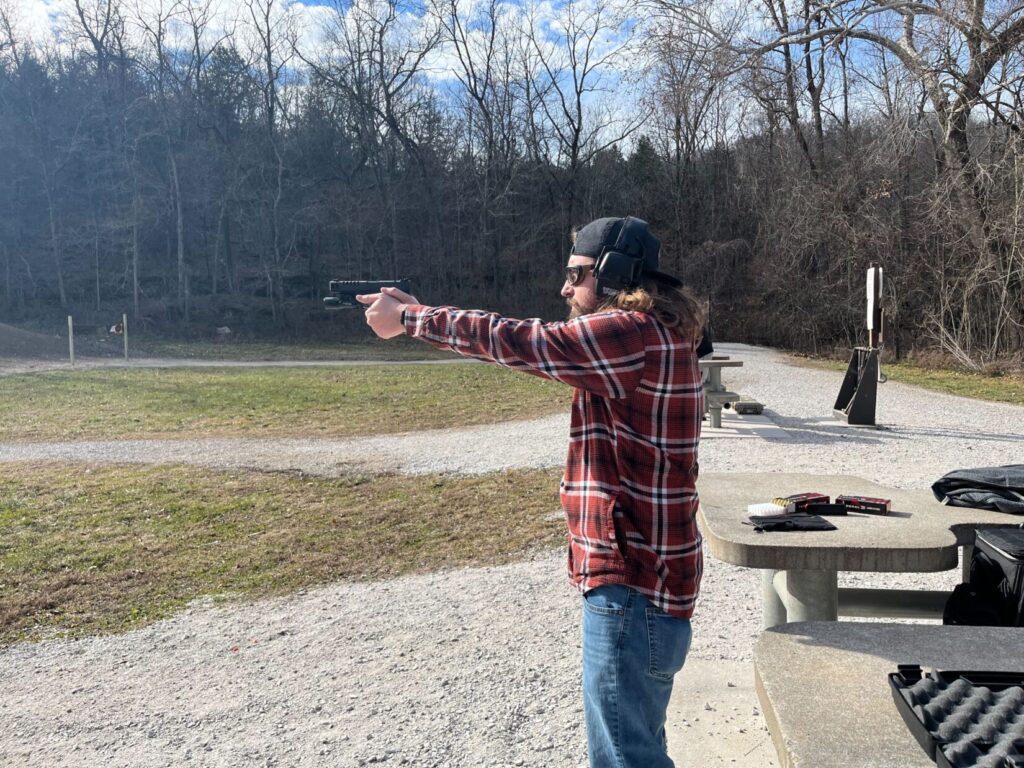
If the problem persists, try a lower-recoiling caliber, like .22 LR. Don’t start with 10mm, .357 Magnum, and other hot loads. I typically advise most new shooters to start with .22 LR or 9mm Luger, as they’re naturally easier to control due to their reliable accuracy with minimal recoil.
Conclusion
Responsible gun ownership begins and ends with you.
A commitment to gun safety fundamentals ensures a secure and enjoyable experience with firearms. Be sure to memorize, practice, and use these basics every time you handle a firearm, and reduce your chances of making a mistake, getting hurt, or catching a charge.
Shooting is a perishable skill, so I always encourage shooters — new and old — to practice, train, and go to the range often. But do it safely; learn safe and smart habits, and break any bad habits you may have picked up along the way.







